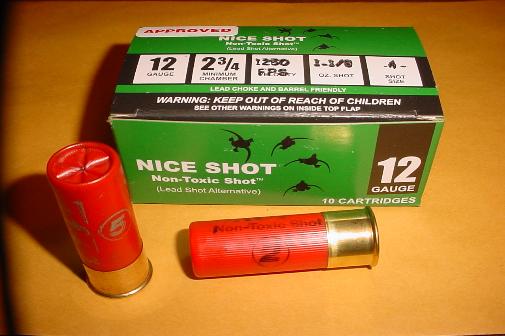


Nice Shot Reloading Pressures

Nice Shot lead replacement, in terms of hardness, runs 14-16 Brinell as. Pure lead, typically 99.85% lead, runs BHN 5. For decades, high performance lead shot also know as “magnum” shot has been created by alloying lead with the lighter and more expensive antimony. Averages vary, but 6% antimony lead is considered “hard” lead. Called the “perfect” casting lead by some, Lyman #2 (90% Lead, 5% Tin, 5% Antimony) runs 15 BHN.
An alloy of 5 percent antimony, .5 percent tin, .17 percent arsenic, and 94.3 percent lead is about 16 Bhn when air-cooled normally, 28 Bhn when quenched directly from a mold, and 36 Bhn when heat treated and quenched. Missouri Bullet Company uses 2% tin, 6% antimony, and the balance in lead resulting in 18 BHN.
Nice Shot, at 14-16 Brinell, is no harder than 5% and 6% antimony lead, or the best “magnum” shot. Hodgdon Powder Company evaluated Nice Shot, and suggested that a comfortable area to load in would be subtracting 1500 PSI from their published lead data, although the average difference in pressure was less.
Reloaders
do like to take pressure numbers far too literally, forgetting that they
are only averages. Hodgdon explored some of the variables in their hardbound
“Shotshell Data Manual” of October, 1996, still a favorite
reference work for me. Page 19 shows how a primer change only can result
in a change from 8400 PSI to 11,200 PSI with a 1-1/8 oz. load. Page 22
shows that a wad change only can result in 8100 PSI to 10,800 PSI, and
page 17 displays what a change in crimp depth can do. Though velocities
did not vary by more than 55 fps, changing the crimp depth of the hull
alone changed pressures from 9300 PSI to 13,100 PSI.
While powder charges and payloads are defined by weight, they are in actuality
loaded by volume. Volume is important in the sense that you want a great-looking
shell with a factory-appearing crimp. As high-antimony shot is harder
and lighter than chilled shot, as is Nice Shot, both will drop slightly
lighter charges by weight as a result, as you will confirm on your scale.
As
a practical matter, it makes good sense to follow Hodgdon's guidance and
keep your reloads at 1500 PSI below SAAMI limits. If you have more questions,
contact your favorite powder manufacturer directly, you can call Nice
Shot, or you can also have your reloads pressure tested by Precision Reloading.
SAAMI Shotgun Pressure Specifications
Shotshell Maximum Average Pressure (MAP) in PSI
10
gauge 11,000
12 gauge 11,500 (except 3-1/2 in.)
12 gauge 3 1/2 in. 14,000
16 gauge 11,500
20 Gauge 12,000
28 gauge 12,500
.410 Bore 2 1/2 in. 12,500
.410 Bore 3 in. 13,500
Preliminary tests performed by Hodgdon showed that when payloads were loaded by actual weight in 12, 20, and 28 gauge: the average differences of all three tests showed "+1400 psi and +29 fps." So, you would use a published lead recipe of 10,100 PSI or less for standard 12 gauge and 16 gauge, a published lead recipe of 10,600 PSI or less for 20 gauge, and a published lead recipe of 11,100 PSI or less for 28 gauge. This is when handloading using actual weight of the payload, which gives you more Nice Shot pellets than the same weight of lead using the same shot diameter.
High-antimony lead runs approx. 11.1 g/cc density. Nice Shot runs about 10.3 g/cc. While lead reloading data is by actual weight, proper shotshell assembly is by dimension. Using a lead charge bar for Nice Shot automatically reduces payload by about 7%, so no pressure issues are plausible.
Links:
http://www.precisionreloading.com
Copyright 2011 by Randy Wakeman. All Rights Reserved.





